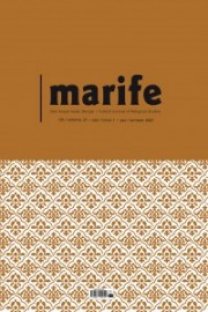HADİSLERİN RİVÂYETİ VE KORUNMASINDA ŞAHSÎ KAYITLAR
Bu araştırmada, hadislerin rivâyeti ve korunmasısürecinde râvîlerin çeşitli tahammül sığalarıyla aldıklarırivayetleri korumalarının destek bir aracıve unsuru olarak geliştirdikleri şahsî not ve kayıtlarının, hadislerin rivâyeti ve metinlerinin sıhhatli inşâsı ameliyesinde nasıl bir katkıda bulunduğu meselesi ele alınacaktır. Hadislerin tamamının Peygamber asrından itibâren yazılı olarak kaydedil[e]memesi olgusu, o dönemde yazı’dan hiçbir şekilde yararlanılmadığı anlamına gelmediği gibi, hadislerin sözlü-yazı-desteksiz bir tarzda geldiği şeklindeki bir iddia da bilimsellik ifade etmez. Belki sözlü-yazı-destekli ancak şifahîliğin ağır bastığı bir metottan söz edilebilir ki, böylesi bir gerçeklik hadis tarihi ve ilimlerinin verilerine daha muvafıktır.
Anahtar Kelimeler:
Hadislerin rivâyeti, Hadislerin korunması, Şahsî kayıtlar, Sahîfe, Kürrâse, Risâle, Kırtâs.
THE ROLE OF THE PRIVATE RECORDS IN NARRATION AND PRESERVATION OF THE HADITHS
It will be examined in this study the question that how and in what extent contribute private records and hypomnemata [memorandum note] that acting a mnemonic device for protection of the traditions which taking up via different methods/modes of transmission of the science (tahammul al-ilm) which were developed by narrators to the process of transmitting of hadiths and building of their texts safely in the course of the narration and preservation of ahadith. The fact that all of the traditions were not be able to write down during the Prophetic period, it not means that this application continues forever. At the same time we find the very considerable amount of evidence for the existence of hadith written down during the life of the prophet. It is known that important body of hadiths was written down, whether on palm leaves, flat stones or in the hearts of narrators during the Prophet’s own lifetime. The traditions that we possess now not reach us only in oral without-mnemonic device of the writing, but in oral-by aiding mnemonic device of the writing to memory
Keywords:
Narration of the hadiths, Preservation of the Hadiths, Private records, Notebooks, Booklet, Letter/epistle, Paper.,
- Yayın Aralığı: Yılda 2 Sayı
- Başlangıç: 31.05.2001
- Yayıncı: Yediveren Kitap
Sayıdaki Diğer Makaleler
HADİSLERİN RİVÂYETİ VE KORUNMASINDA ŞAHSÎ KAYITLAR
MUHAFAZAKÂR DEĞERLER VE KADIN SORUNSALI: YENŞAFAK GAZETESİNDE KÖŞE YAZARLARI ÖRNEĞİ
İSLÂM DÜNYASININ İNHİTATI SEBEBİ SELÇUK İSTİLÂSI MIDIR?
MESNEVÎ EKSENİNDE MEVLÂNA’NIN ANLAŞILMA(MA)SI ve NEDENLERİ ÜZERİNE
Doğu-Batı İlişkisinin Entelektüel Boyutu Uluslar arası İbn Rüşd Sempozyumu 9-11 Eylül 2008-Sivas
İBN TEYMİYYE’NİN SÜNNET ANLAYIŞI VE ÇİZDİĞİ EHL-İ SÜNNET PROFİLİ
MUHAFAZAKÂR DEĞERLER VE KADIN SORUNSALI: YENŞAFAK GAZETESİNDE KÖŞE YAZARLARI ÖRNEĞİ
Tarihte ve Günümüzde Kur’an İlimleri ve Tefsir Usûlü (Kur’an ve Tefsir Akademisi)
EYYÂMU’L-ARAB (ARAP SAVAŞLARI) BAĞLAMINDA ZÛKÂR SAVAŞI VE ŞİİRLERİ ÜZERİNE BİR İNCELEME
